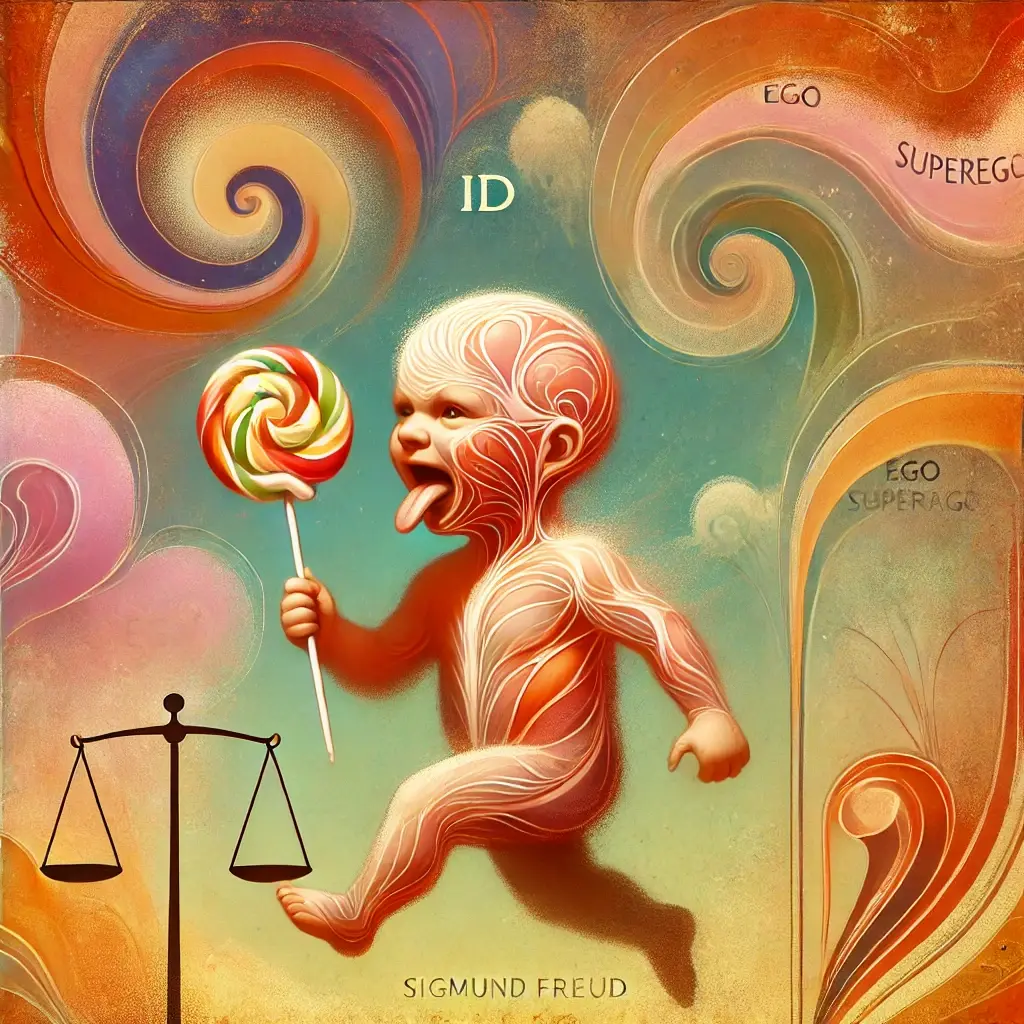Let’s get one thing straight: if you’re Googling “The id is most similar to what concept?” you’re already more self-aware than your id would like. It’d probably prefer you search for “how to get instant gratification without consequences.” But alas, here we are, delving into Freud’s psyche and unraveling the mysteries of human behavior instead of, say, buying that expensive gadget you don’t need.
Now, buckle up—we’re about to explore the wild, impulsive world of the id, your brain’s version of a toddler hyped on sugar.
What Exactly is the Id?

The id, as Sigmund Freud defined it, is the instinctual and unconscious part of the human psyche. It’s where all your basic drives—hunger, thirst, sex, and survival—reside. It doesn’t care about logic, morality, or future consequences; it just wants what it wants, and it wants it now. Think of it as your brain’s unfiltered “Want Machine.”
Need a refresher on how the id fits into Freud’s broader model alongside the ego and superego? Head over to Exploring Freud’s Psychological Concepts: Id, Superego, and Ego for a deeper dive.
What’s the Id Most Similar To?
If you’re wondering what modern concept best aligns with the id, here are some strong contenders:
Raw Instincts
Imagine the id as your inner caveman, a primal force that operates on pure instinct and immediate gratification. It’s the part of you that yearns for instant pleasure, whether it’s devouring a decadent dessert, lashing out in anger, or seeking immediate comfort. It’s the voice that whispers, “Eat the cookie now, worry about the consequences later.”
This primal force isn’t inherently bad; it’s a fundamental part of our human nature. It drives our basic survival instincts, ensuring our needs for food, shelter, and safety are met. However, when unchecked, the id can lead to impulsive decisions, self-destructive behaviors, and a disregard for long-term consequences.
Think about the last time you were tempted to indulge in a guilty pleasure, knowing full well it wasn’t the healthiest choice. That internal struggle between immediate gratification and long-term goals is a classic example of the id at work. It’s the part of you that wants to give in to temptation, while your rational mind tries to resist.
Understanding the id is crucial for self-awareness and personal growth. By recognizing its influence, we can learn to manage its impulses and make more conscious choices. It’s about finding a balance between our primal instincts and our higher-level thinking, allowing us to live a more fulfilling and balanced life.
The Limbic System
The limbic system, often dubbed the “emotional brain,” is a network of interconnected structures deep within the brain. It plays a crucial role in regulating our emotions, memories, and instinctive behaviors. This intricate system is closely linked to the id, the primal part of our psyche that drives our basic instincts and desires.
Just like the id, the limbic system operates on an unconscious level, influencing our thoughts and actions without our conscious awareness. It’s responsible for the intense emotions we experience, such as love, anger, fear, and joy. When we feel a sudden surge of adrenaline or a pang of hunger, it’s the limbic system at work.
By understanding the limbic system, we can gain valuable insights into our own behavior and the behavior of others. It helps us appreciate the power of emotions and the importance of emotional intelligence. By learning to manage our emotional responses, we can make more rational decisions and build healthier relationships.
A Toddler in a Candy Store
Freud aptly compared the id to a toddler, a creature of pure impulse and immediate gratification. Like a child in a candy store, the id is driven by an insatiable desire for pleasure, oblivious to the consequences of its actions. It demands instant satisfaction, regardless of societal norms or practical limitations.
This childlike aspect of the id is what makes it so powerful and yet so challenging to control. It’s the part of us that yearns for instant gratification, whether it’s indulging in a delicious dessert, lashing out in anger, or seeking immediate comfort. It’s the voice that whispers, “I want it now!”
While the id’s impulsiveness can sometimes lead to reckless behavior, it also plays a vital role in our survival. It drives our basic instincts, ensuring that we seek food, shelter, and safety. However, when left unchecked, the id can lead to self-destructive behavior and a disregard for the needs of others.
For a look at how this internal tension creates anxiety and shapes your behavior, don’t miss The Inner Conflict: Id and Superego, Anxiety, and Your Path to Personal Empowerment.
Why Understanding the Id is Important
The id isn’t inherently bad—it’s essential for survival and pleasure. But if left unchecked, it can lead to impulsive decisions that conflict with your goals or moral compass. Recognizing your id allows you to strike a balance, giving your inner wild child just enough freedom without letting it take over.
Curious about how your mind protects itself from these inner conflicts? Check out Exploring Ego Defense Mechanisms: Navigating Inner Conflict.
So, what’s the id most similar to? It’s your raw instincts and unconscious drives, the part of you that acts before thinking. While it might lead to regrettable late-night pizza orders or spontaneous online purchases, it’s also a reminder of your humanness. After all, life without a little impulsivity would be pretty dull—and the id wouldn’t stand for that!
Get the next post in your email.



0 Comments